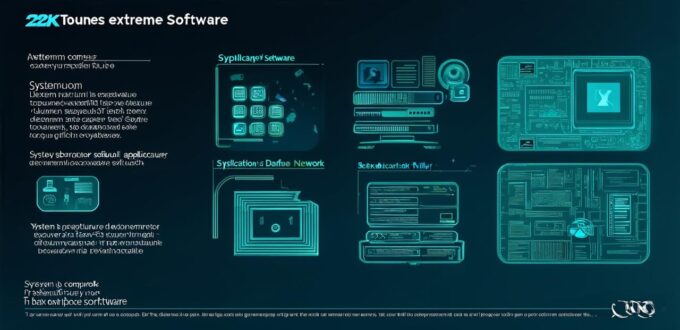Computer software is a critical component of modern technology and has transformed many industries. It can be broadly classified into six categories: Operating Systems, Productivity Software, Multimedia Software, Application Software, System Software, and Embedded Software. In this article, we will explore each category in detail and understand its significance.
Operating Systems

An operating system (OS) is a program that manages the computer’s hardware resources and provides a platform for running other software programs. It acts as an intermediary between the user and the hardware and manages tasks such as memory allocation, file management, network communication, and security. Examples of popular operating systems include Windows, macOS, Linux, Android, and iOS.
Productivity Software
Productivity software is designed to help individuals and businesses accomplish their daily tasks efficiently. It includes programs such as word processors, spreadsheets, presentations, email clients, and project management tools. These software applications are used for creating documents, managing schedules, collaborating with team members, and analyzing data. Examples of popular productivity software include Microsoft Office, Google Workspace, and LibreOffice.
Multimedia Software
Multimedia software is designed to create, edit, and share digital media content such as videos, images, audio files, and games. It includes programs such as video editors, photo editors, music production software, and gaming engines. These software applications are used for creating high-quality multimedia content that can be shared on social media platforms or distributed to a wider audience. Examples of popular multimedia software include Adobe Creative Suite, Final Cut Pro, and Unity.
Application Software
Application software is designed to perform specific tasks and is used by individuals and businesses to accomplish specific goals. It includes programs such as antivirus software, web browsers, office suites, and file compression tools. These software applications are designed to meet the needs of a particular user or group of users and are often customized for specific industries or business functions. Examples of popular application software include Norton Security, Google Chrome, and Microsoft Excel.
System Software
System software is designed to manage the computer’s resources and provide support for other software programs. It includes programs such as device drivers, firmware, and utilities. These software applications are used for managing hardware components, maintaining system stability, and troubleshooting issues that may arise. Examples of popular system software include NVIDIA GeForce Drivers, Windows Update, and MacOS Utilities.
Embedded Software
Embedded software is designed to run on specialized hardware devices such as routers, smartphones, medical equipment, and automobiles. It includes programs that are optimized for specific hardware platforms and are designed to perform specific tasks efficiently. Examples of popular embedded software include firmware in smartphones, operating systems in routers, and control systems in vehicles.
Comparing the Six Categories of Computer Software
Each category of computer software has its unique features and functions. However, there are some similarities between them. For example, all categories require resources such as memory, processing power, and storage space to function effectively. Additionally, most categories have some level of user interaction, whether it is through a graphical user interface or command-line interface.
One significant difference between the categories is their intended use. Operating systems are designed to manage hardware resources, while productivity software is designed for specific tasks such as document creation and data analysis. Multimedia software, on the other hand, is designed to create and edit digital media content, while application software is designed for specific business functions or industries. System software is designed to manage system resources and troubleshoot issues that may arise, while embedded software is designed for specialized hardware devices.
The Significance of Computer Software Categories
Computer software categories play a critical role in the success and efficiency of businesses and individuals. The right software tools can help individuals and teams accomplish their tasks quickly and efficiently, while the wrong tools can hinder progress and slow down productivity. Additionally, understanding the different categories of computer software can help individuals and businesses make informed decisions about which software tools to use and when to use them.
Case Study: How Computer Software Categories Helped a Small Business Succeed
A small business owner named John started a new bakery in his town. He had no experience running a business and was unsure of what software tools he needed to manage his operations. After some research, John decided to invest in an accounting software suite to manage his finances, a point-of-sale (POS) system to manage his sales, and inventory management software to track his stock levels.
John’s decision paid off. The accounting software helped him keep track of his expenses and revenue, while the POS system allowed him to manage his sales efficiently and quickly. The inventory management software helped him avoid stock shortages and overstocking, which saved him money on storage costs. Additionally, John was able to use his mobile device to manage his business operations from anywhere, which allowed him to be more flexible and responsive to customer needs.
Expert Opinion: What is the Future of Computer Software Categories?
The future of computer software categories is likely to be shaped by advancements in artificial intelligence (AI), machine learning (ML), and cloud computing. These technologies are likely to make software tools more intelligent, adaptable, and scalable, which will help businesses and individuals accomplish their tasks more efficiently. Additionally, the increasing use of mobile devices and social media platforms is likely to drive the development of new software tools that are designed for these platforms.
FAQs: Frequently Asked Questions about Computer Software Categories
1. What is the difference between operating systems and productivity software?
Operating systems manage hardware resources, while productivity software is designed for specific tasks such as document creation and data analysis.
2. What is the purpose of system software?
System software manages system resources and provides support for other software programs.
3. What is an example of embedded software?
Firmware in smartphones is an example of embedded software.
4. How can computer software categories help a small business succeed?
Computer software categories can help small businesses manage their finances, sales, and inventory efficiently, which can save them money and improve their productivity.
